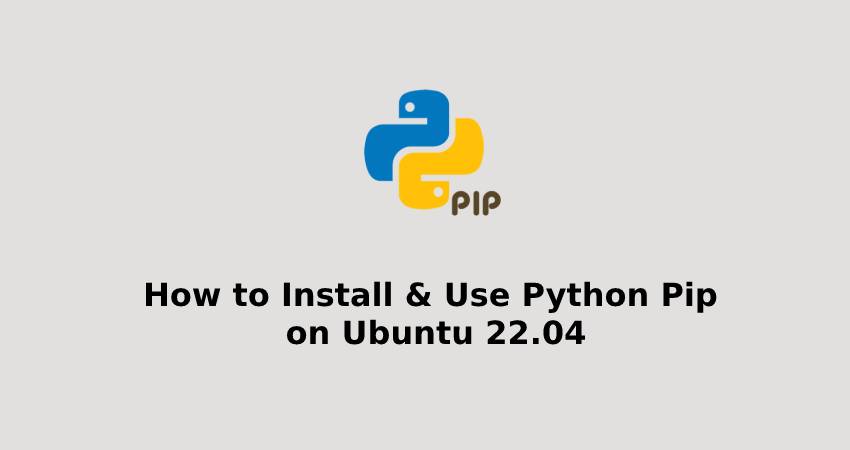Python is one of the most popular programming languages used today. It has an extensive library of modules and tools, which makes it a versatile language. Pip is a package installer for Python that helps manage Python packages and dependencies. In this tutorial, we will walk through the steps to install Python Pip on Ubuntu 22.04.
Important Notes Before You Begin
Before installing and using pip on Ubuntu 22.04, there are a few things to keep in mind:
Choosing Python Version
Ubuntu 22.04 comes with Python 3 pre-installed, which is recommended for new projects. If you need to use Python 2 for legacy reasons, you can install it using the default Ubuntu repositories. However, note that Python 2 has reached its end-of-life and is no longer supported by the Python community.
Using apt versus pip
It’s generally recommended to use the apt tool to install deb packages for Python modules, whenever possible, as these packages are tested and verified to work properly on Ubuntu systems. Only use pip to install packages globally if there is no deb package available.
Virtual Environments
When using pip, it’s recommended to do so within a virtual environment. Virtual environments allow you to install Python packages in an isolated location specific to a particular project, rather than being installed globally. This way, you can avoid affecting other Python projects or the system Python installation. It also makes it easier to manage dependencies and ensure compatibility between packages.
How to Update Your System
Before installing Pip, it’s always a good idea to update your system packages to the latest version. This can be done using the following command:
sudo apt updateThis command updates the package index and ensures that you have the latest version of all installed packages on your system.
How to Install Pip for Python 3
Ubuntu 22.04 comes with Python pre-installed. However, Pip needs to be installed separately. To install pip for Python 3, you can run the following command:
sudo apt install python3-pipOnce Pip is installed, you can verify its installation by running the following command:
pip3 --versionThis command should display the version of Pip that’s installed on your system. If you see an error message, it means that Pip is not installed correctly.
Output
pip 21.3.1 from /usr/lib/python3/dist-packages/pip (python 3.8)The exact version number and path may vary depending on your system configuration. If pip is not installed, the command will output an error message indicating that pip cannot be found.
How to Install Pip for Python 2
Ubuntu 22.04 does not include Pip for Python 2 in its repositories. However, you can install it using the get-pip.py script. If you do not already have Python 2 installed on your system, you can install it using the following command:
sudo apt update
sudo apt install python2To download the get-pip.py script, use the curl command:
curl https://bootstrap.pypa.io/pip/2.7/get-pip.py --output get-pip.py
To install Pip for Python 2, run the get-pip.py script with the python2 binary as a sudo user:
sudo python2 get-pip.pyIf you prefer to install Pip only for your user, run the command without sudo. The get-pip.py script also installs the setuptools and wheel packages, which allow you to install source distributions.
To verify that Pip for Python 2 is installed correctly, run the following command:
pip2 --versionThe output should resemble the following:
pip 20.3.4 from /usr/local/lib/python2.7/dist-packages/pip (python 2.7)
It’s important to note that Python 2 has reached its end-of-life and is no longer being actively maintained or updated. It is strongly recommended to upgrade to Python 3 if possible to ensure ongoing support and security.
How to Use Pip for Python 3
Pip is a package manager that allows you to install, upgrade, and uninstall Python packages. To see a list of all pip commands and options, you can enter the following command in your terminal:
pip3 --helpIf you need more information about a specific command, you can use the following format:
pip3 <command> --helpFor example, if you want to know more about the install command, you can use the following command:
pip3 install --helpThis will give you more information about how to use the install command, including its options and arguments.
How to Install Packages with Pip
To install a package with pip, you can run the following command:
pip3 install package_nameFor example, to install the Flask web framework, you can run the following command:
pip3 install flaskTo install a particular version of a package, you can use the pip package manager along with the double equal sign and the version number you desire. For example, if you want to install version 1.18.5 of the numpy package, you can use the following command:
pip3 install numpy==1.18.5Please note that if you are using Python 2, you should replace “pip3” with “pip2” in the command above.
How to Install Packages with Pip using the Requirements Files
You can also use a requirements file to install packages with pip. A requirements file is a text file that contains a list of packages and their versions. You can create a requirements file by running the following command:
pip3 freeze > requirements.txtThis command will create a requirements.txt file in the current directory that contains a list of all the installed packages and their versions. You can then use this file to install the same packages on another machine by running the following command:
pip3 install -r requirements.txtHow to List Installed Packages
To list all the installed packages, you can run the following command:
pip3 listThis command will display a list of all the installed packages along with their versions.
How to Upgrad a Package with Pip
To upgrade a package with pip, you can run the following command:
pip3 install --upgrade package_nameFor example, to upgrade the Flask web framework to the latest version, you can run the following command:
pip3 install --upgrade flaskHow to Uninstall Packages with Pip
pip3 uninstall package_nameFor example, to uninstall the Flask web framework, you can run the following command:
pip3 uninstall flaskHow to Use Virtual Environments
It’s a best practice to use virtual environments when working with Python packages. A virtual environment is an isolated Python environment that allows you to install packages without affecting the system Python installation or other projects. To create a virtual environment, you can run the following command:
python -m venv myenvThis command will create a new virtual environment named myenv. You can then activate the virtual environment by running the following command:
source myenv/bin/activateOnce the virtual environment is activated, you can install packages using pip as usual. When you’re done working with the virtual environment, you can deactivate it by running the following command:
deactivateHow to Configure Pip
You can configure pip by creating a pip.conf file in your home directory. This file allows you to set default options for pip, such as the location of package repositories or the default version of Python to use. You can create the pip.conf file by running the following command:
nano ~/.pip/pip.confThis command will open a new file in the nano editor. You can then add your configuration options to the file and save it.
Global versus User Packages
When you install packages with pip, you can choose to install them globally (for all users) or locally (for your user account only). By default, pip installs packages locally in your user account. If you want to install packages globally, you need to run pip with the sudo command:
sudo pip3 install package_nameHowever, it’s generally recommended to avoid installing packages globally, as this can lead to conflicts between different projects.
Conclusion
Pip is a powerful tool for managing Python packages and dependencies. By following the steps outlined in this guide, you should now be able to install, upgrade, and uninstall Python packages using pip on your Ubuntu 22.04 system. Remember to always use virtual environments and be careful when installing packages globally. Happy coding!
Got questions or suggestions on the article? Don’t hesitate to leave a comment below. Your feedback is valuable to us and helps improve the content quality. And don’t forget to share this article with others who might find it useful. Looking forward to hearing from you!
If our tutorials helped you, please consider buying us a coffee. We appreciate your support!
Thank you for your support.


